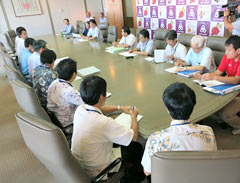Okinawa detects Agent Orange ingredients in barrels found on land returned by U.S. military

In the morning of July 24, in a meeting held in the city government office involving the Okinawa Defense Bureau, the Okinawa Prefectural Government and the Okinawa City Government the bureau said it detected levels of dioxin and other harmful ingredients exceeding the Environmental Quality Standard.
July 25, 2013 Ryukyu Shimpo
Construction workers unearthed dozens of barrels marked with the logo of the Dow Chemical Company at a soccer ground on land returned by the U.S. military in Okinawa City. The Okinawa Defense Bureau said on July 24 that it detected dioxin and other harmful ingredients in the fouling material inside the barrels and in water near the location. The levels found exceeded the Environmental Quality Standard set by the Japanese government. During the Vietnam War, the United States based chemical manufacturer produced Agent Orange, a chemical defoliant containing dioxin.
The bureau detected dioxin in fouling material at a level 1.1 times the normal standard for soil, and in the water it was 28 times the standard for groundwater. Experts insist that this is a variety of dioxin related to the defoliant.
The bureau reported the results of their investigation in a meeting held in the city government office on the morning of July 24. The meeting involved representatives of the bureau, the Okinawa Prefectural Government and Okinawa City Government. Afterwards, Okinawa City Mayor Mitsuko Tomon announced that a full-scale investigation will be carried out at the soccer ground. The three parties plan to deal with the issue after the city government releases the investigation results at the end of this month.
The bureau detected dioxin in all the 22 analytes from the barrels. Two exceeded the standard and the highest value was 1,100 picograms TEQ per gram. The others ranged from 62 to 1,000 picograms. TEQ stands for Toxicity Equivalence Quantity, which indicates the toxicity of dioxins.
The dioxin in the water around the soil was 28 picograms TEQ per liter.
The bureau found the key ingredient of Agent Orange – 2, 4, 5-T, trichlorophenoxyacetic acid, in 13 of the analytes from the barrels. They did not detect the other key ingredient of the defoliant – 2, 4-dichlorophenoxyacetic. The bureau said they cannot say for sure that Agent Orange was in the containers.
They explained that the U.S. military used 2, 4, 5-trichlorophenoxyacetic acid in many herbicides during the Vietnam War. A bureau representative said, “It is possible the barrels contained Agent Orange.”
At the site, the bureau found a large quantity of 2, 3, 7, 8-tetrachlorodibenzo, an ingredient unique to the defoliant. Katsuhisa Honda, a professor at Ehime University, who studies dioxin and techniques for its analysis, focuses on this fact.
Honda asserted, “I am sure the barrels contained dioxin related to Agent Orange because the ingredient accounted for 70 percent of the chemical.” He emphasized the need to clean the contaminated soil.
The bureau did not detect polychlorinated biphenyls in the barrels or around the soil. They found 140 picograms of dioxin TEQ per gram, which is lower than the standard, in the soil. Levels of arsenicum and fluorine found were slightly lower than the standard.
(English translation by T&CT, Mark Ealey)
Previous Article:Residents to promote tourism focusing on Haneji Inland Sea
Next Article:Shimabukuro becomes first Yakuzen Dietetics Master in Okinawa
[Similar Articles]
- Levels of Agent Orange ingredients found in Okinawa City exceed Environmental Quality Standard
- Dioxins detected in all analyses of barrels found in Okinawa City
- Toxic dioxin found inside barrels unearthed at a soccer ground on land returned by the U.S. military in Okinawa City
- [Editorial] US and Japan need to investigate Agent Orange in Okinawa
- U.S. military storage of Agent Orange in Okinawa
 Webcam(Kokusai Street)
Webcam(Kokusai Street)


